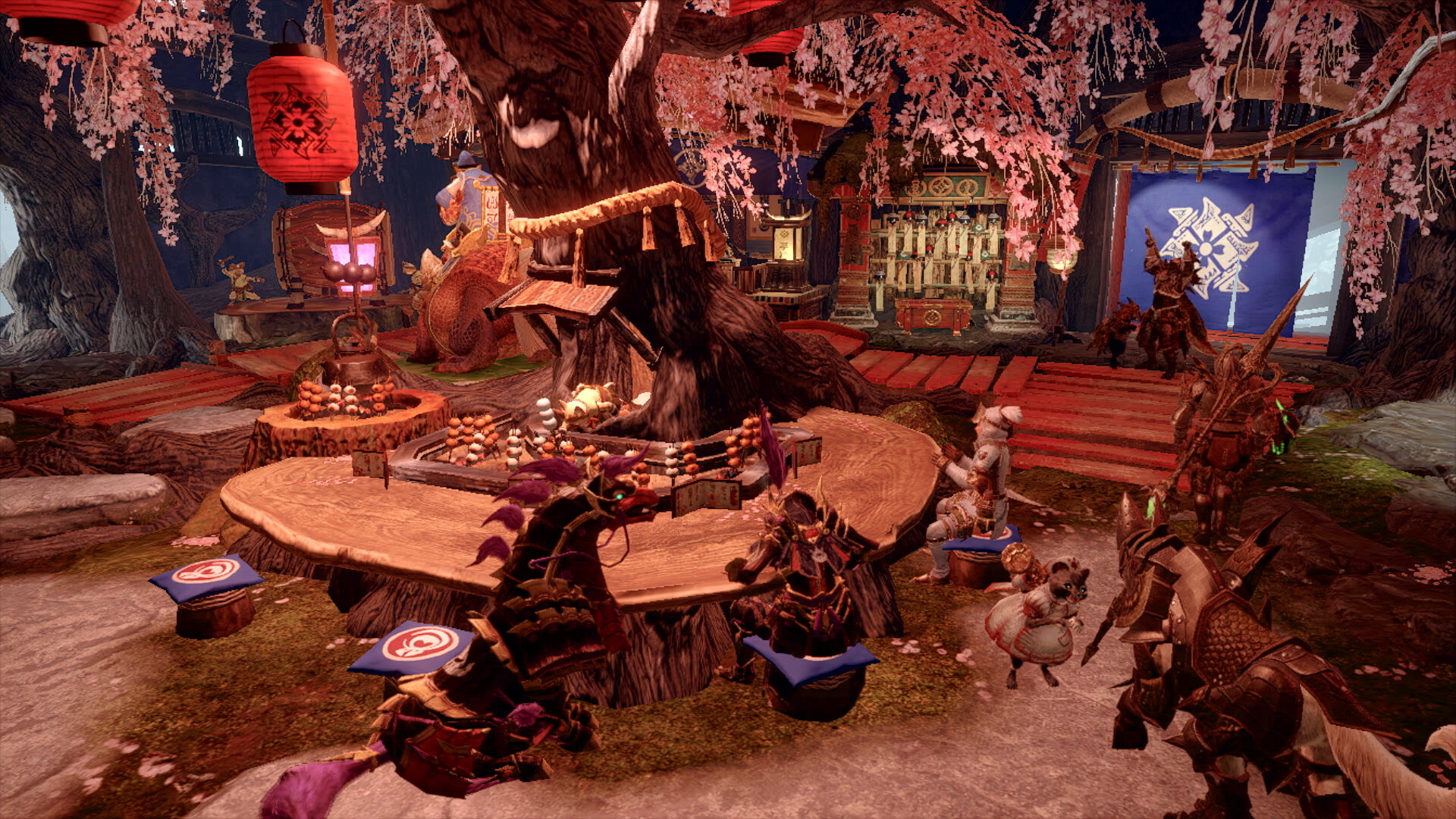Monster Hunter: Rise feels like going home for the holidays

This is a first-impressions review.
If listening is your thing, you can listen to the FirstByte podcast version of this review.
The first time you boot up a new Monster Hunter game on launch day it always feels satisfyingly familiar.
It is very nostalgic and somehow is always reminiscent of going back home for the holidays. Capcom gives you that warm and comforting feeling in a place that you mostly recognize, but there are tiny little differences that make it exciting to catalog each and every holiday.
This is precisely why Monster Hunter fans spend the first hour or more in their new hub town just poking through all of the details to bask in the new setting while taking inventory of all the things your parents have moved around or changed in their facade since the last time you were here.
With the release of Monster Hunter: Rise – on Nintendo’s flagship dynamic portable and home console hybrid – it was more important than ever to reach the freshly minted version of Monster Hunter comfort and nostalgia.
A few years back (late 2017 to be exact) the Monster Hunter formula was upgraded in a gigantic way thanks to the launch of Monster Hunter: World on home consoles followed by a PC port. This brought hunters out of a flat, single-camera angle environment, and into the controllable camera 3D world that we know and love today. It revolutionized the experience in many ways and played a major part in grabbing the attention of many non-Monster Hunter fans. In 2021, the abundance of players that put hundreds of hours into World meant that there was a ton of pressure on Rise to continue the momentum into the future while minimizing things a bit in order to make it playable on a portable console.
For the most part, Monster Hunter: Rise does everything it has to in order to make it feel that the video game series isn’t taking a step backward from its dominant showing on home consoles last generation.
While I adored the plaza and hub of World, there is something small-town, and very Japanese village flavored with the new town in Rise, and it is very much my new happy place. Upon re-entry, after every hunt or mission, everything about Kamura village warms my belly like a steaming bowl of Ramen.
Keeping the three-dimensional world from the previous entry, Kamura Village feels more alive than entries prior to World. Looking around the village to observe every tiny detail is engrossing. It’s vibrant, welcoming, and Capcom has come a long way in making its systems streamlined and new-user friendly, which perfectly introduces you to all of the new faces and places around the hub.
As for the actual on-boarding of new players, there is nothing too complicated, and with the game’s built-in rollout of new features, as your Hunter gets their bearings, the game isn’t throwing a mountain of systems and features at players less familiar with common Monster Hunter all at once. Rise may just be the most friendly game in the franchise’s history.
The ease of new-player adaption being fantastic isn’t to say that there isn’t enough in the game for the seasoned hunters. From Dango-optimization to a handful of side-quests you can always have going at any time, and the magnified difficulty of hunting in a full online party, Rise is as deep as any other mainline entry into the franchise, and even more balanced and intricate than most.
As veteran hunters know, eating is a large part of the hunt preparation stage of gameplay found in Monster Hunter titles, and in Rise, there is a new Dango formula for hunters to min-max and tailor to their specific needs. A full Dango is three buns on a stick, and players can choose each part of the three-part meal. Each particular Dango can grant different buffs, from potentially taking less damage to resistances to specific elements, and even the chance to gain extra carving opportunities. It’s a fun system, and it feels particularly poignant when attempting difficult hunts. Picking the right combo of buffs and using Dango tickets to ensure the rolls, is a wonderful experience each and every time. Eating is as fun as ever in Rise, as the song and dance number that accompanies the cooking scene follows Rise’s new pattern of joyful rhymes and poetic hooks.
Taking a look at the actual monster hunting, Rise comes in swinging light but packs a pretty heavy punch. At launch, the newest hunter game has 61 total monsters on the list, 35 large monsters, and 26 small ones. This may seem small in comparison to the previous titles, but it’s important to remember that Capcom has done a phenomenal job of supporting these titles in years past, and there is an expectation that Rise will receive numerous updates in the coming years.
Of the 61 beasts to hunt or capture, 47 are returning members of the infamous line-up of Monster Hunter targets, and Rise brings 14 brand new monsters to the party.
So far, through my early journey to rank up my hunter, I have had some pretty memorable run-ins with the new line-up of monsters. For better and for worse. Monsters like the Bishaten’s wily movement and unique attacks and the dancing Aknosom are some of the best new additions, while creepy and returning beast the Khezu remains one of the grossest and most uncomfortable fights in Monster Hunter history. Annnnd I hate it. No thank you, Capcom.
For all of the good that Monster Hunter: Rise does to continue this new pedigree of intricate and immersive hunting, there are some notable crumbs left on the cutting room floor that many Monster Hunter: World players will miss. The most notable downscale in Rise, is the incredibly impactful stalking and sneaking abilities introduced in World. There was something special about using a ghillie suit to disengage from a monster, only to sneak through the bushes either avoiding or approaching reengagement. It made The HUNT feel more alive. Grossly, it attributed a large portion of making the player feel like a tiny portion of a monstrous world.
In the same breath, system limitations -- the presumed reason -- have made for less flourishing flora around the maps. However sparse the bushes and harvesting spots may be in comparison to World, the new Wirebug functionality has opened up the maps horizontally.
What the worlds lack in density, they make up for in vertical exploration, and it’s this change in scenery that makes it almost unnoticeable that things have been scaled back when it comes to the lush ground environment.
Despite the step backwards, I am unsure that I have ever felt the stunning awe that washed over me through adventuring and exploring the new maps in Monster Hunter Rise, in any other game of recent memory. Through study and exposure, the world feels extremely immersive in majority due to the player’s accessibility and movement. Nearly every corner of the multi-layer maps are traversible, and it works a magic trick on the brain in terms of truly feeling like you are there.
In addition to new movement and combat provided by zippy wirebugs, the other monumentally unforgetable new mechanic in Rise is Palamutes. You’ve had cat partners in the past, but Capcom finally gave us pups. These goodest doggos not only provide new functionality in combat, but they also act as mounts for the hunters, allowing you to traverse these beautifully redesigned Monster Hunter maps in an entirely new way. Dog buddies are the future, and there is no going back now.
Quite possibly the most significant positive aspect to Rise is the potential longevity. We’ve just spent the last half-decade watching Capcom purposefully update the content for World, and if they play their cards right, hunters will be inundated with Rise for years to come.
At this stage in the Monster Hunter franchise, we may have to assume that the team at Capcom will alternate between handheld titles and console titles. Though, there is vibrant possibilities that the future plans for the series will see a Nintendo portable release initially, followed by ports to consoles and PC. In an interview with Fanbyte back in February of this year, series Producer Ryozo Tsujimoto and director Yasunori Ichinose mentioned that a PC port of Monster Hunter: Rise is coming, but not until early 2022.
We saw a trend similar with World, in which the console game release separated PC launches by more than half a calendar year. If the roadmap continues to include early launches on Nintendo’s flagship system followed by integral ports to other platforms, may prove to be the recipe that will continue to grow the Monster Hunter brand to monstrous size.
If you are a fan of intricate combat, purposeful preparation, difficult to master combat, ever-growing threats, and the practice of min-maxing everything about your gear loadout and weaponry than at its core, Monster Hunter: Rise is a game you should play. Just remember to take your time, and soak in the scenery.
Subscribe, like, and follow the FirstByte podcast on your favorite podcast app today.





